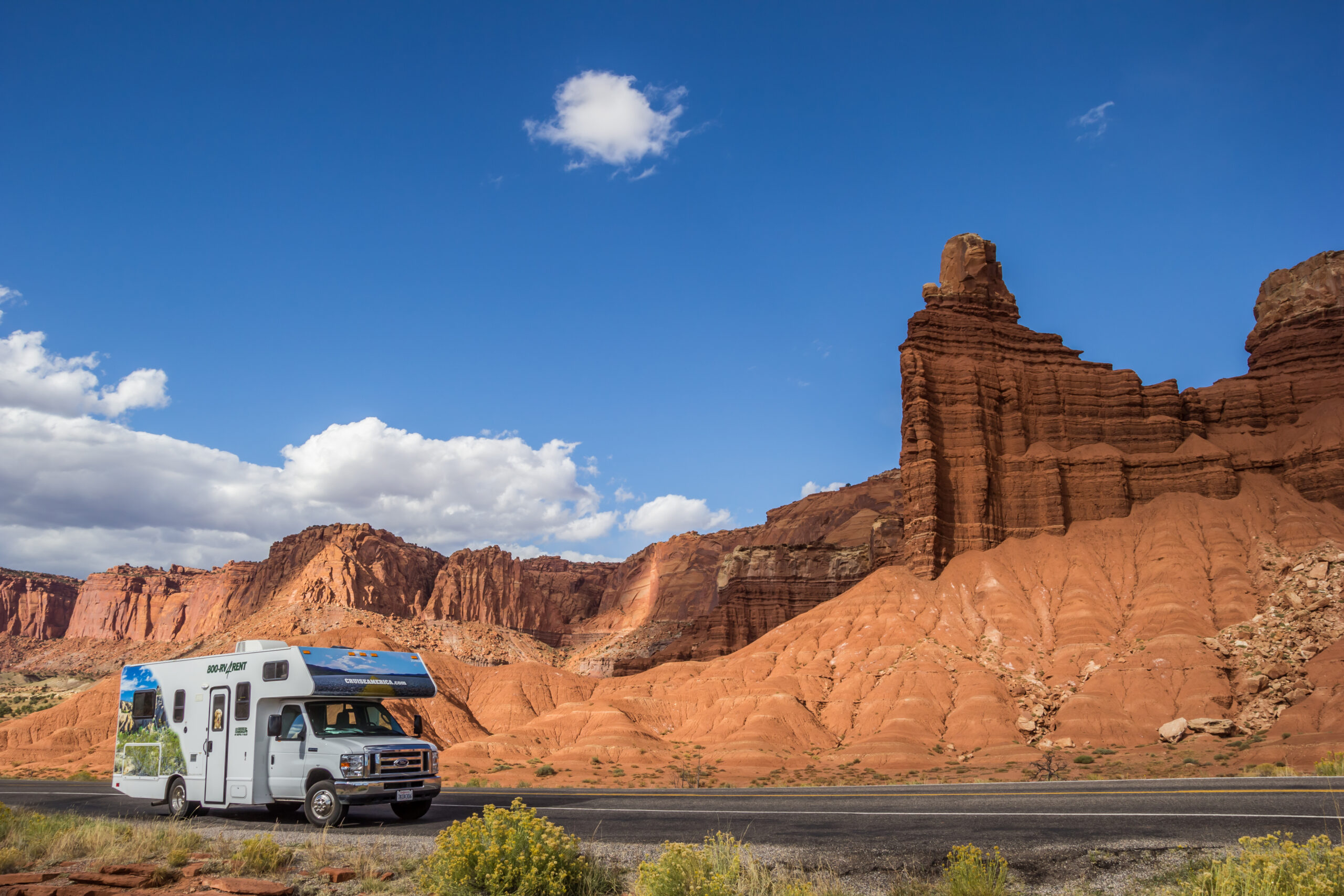The Ultimate Guide to RVing in National Parks
There’s nothing quite like waking up in your cozy cabin and walking out the door to gaze up at Yosemite’s Half Dome, or taking a short walk to the rim of the Grand Canyon, immersed in nature but still with your own shower and cushy bed to fall into after a day outdoors. Even better, tomorrow you could brew coffee in the same kitchen and walk out to an epic view in Sequoia National Park, or Zion, or wherever your wheeled home may have taken you. This is the magic of RV travel: the feeling of a cozy wilderness cabin combined with the freedom to take that cabin on the road.
Traveling by RV offers a great way to tour multiple parks on expansive road trips that make the most of your America the Beautiful Pass. In fact, RVs are such a good match for National Parks, they accounted for over 2.5 million overnight park stays in 2018 (the latest numbers available), with 250,000 RV visitors to Yosemite alone, according to RVIA, the Recreational Vehicle Industry Association. The coronovirus pandemic has only seen RV purchases increase, too: RIVA predicts 2021 will be its best year on record, with over 500,000 new RVs expected to ship.
Recreational Vehicles are “the perfect middle ground between hard camping and all the comforts of a hotel room,” says Dan Wulfman, President of Tracks and Trails RV tour agency. “You can be reasonably comfortable and reasonably remote at the same time, right in the middle of it all.”
Perhaps the best thing about traveling by RVs is that they give you “the freedom to explore,” says new RV-owner Adam Kaufman, who drove over 5,000 miles in his new RV this summer to visit 10 different National Parks and Monuments with his wife and three children. “We went where we wanted, when we wanted, and it made memories for our kids they’ll never forget,” he said of their trip.
Even so, traveling by RV to National Parks can be intimidating, especially if you’re new to this style of transport. Follow our essential tips and tricks to maximize your RV experience in and around the National Parks.
1. Pick the Best Size RV for National Parks—and for You
Once you’ve decided to take the plunge and visit a National Park with an RV, the first thing you need to do is pick your rig. The biggest decision to make is size. You’ll have to choose between the maneuverability and ease of a smaller vehicle and the amenities and camping comfort of a larger RV.
If you’re a first time driver, before you rent a larger RV for a long-haul trip, be sure to take one for a test drive first, to assess your level of comfort of driving with it. “My advice is to take the smallest vehicle you’ll feel comfortable in,” says Wulfman.
Understanding Recreational Vehicle Classes
RVs come in three classes, offering different sizes and amenities. Some are better for large groups, others if you’re just traveling as a couple. Pick the one that’s right for you—and where you want to go.
Class B: The smallest category, Class B custom-van campers usually come with a mini kitchen and pop-up sleeping area. They’re a good fit for a couple and a step up from car-camping, but lack the “mobile cabin” experience of a larger RV.
Class C: In the midrange category, Class C RVs are a good fit for a family of four. They fall in the 25-foot range—below the cut-off threshold for many park campgrounds—and combine manageable living space with a reasonably easy-to-handle driving experience on hilly National Park roads.
Class A: The largest category, Class A motorhomes start at about 30 feet, and have many of the comforts of home, but with notable drawbacks: They take some adjustment to drive, what with their massive bus chassis, and may also be restricted from some National Park roads and campgrounds.
2. Where to Book Your RV Rental
Start with nationwide rental providers to get a sense of what’s out there. The popular RV rental company Cruise America, offers a full range of motorhome options, while Outdoorsy, which bills itself as the “Airbnb of RV rentals,” provides everything from luxury to cheap RVs via peer-to-peer bookings.
If you’ll be leaving from the West Coast, several boutique options have cropped up recently that cater specifically to road trips in California, Utah, and parts of the Southwest: Jucy rents camping vans in Los Angeles, Las Vegas, San Francisco (ideal if you’re looking to visit Utah or California parks); GoSilver specializes in Airstreams out of the San Francisco Bay Area (perfect for California park roadtrips); while Roamamerica offers tricked-out camper vans from Portland, Oregon and Cabana rents out camper vans billed as “mobile hotels” from Seattle (should you be planning to explore parks in the Pacific Northwest).
3. Most Parks Welcome RVs
Given the popularity of RV travel to National Parks, most parks provide an RV-friendly environment for arriving and touring in the large vehicles.
Main parking lots typically have designated areas for RVs, main roads are usually wide with generous turnouts, and your fellow drivers are used to the slow-moving behemoths, so there’s no need to feel self-conscious as you putt-putt your way up a big incline with a row of cars backed up behind you (just politely pull over into the occasional turnout to let them pass.)
4. Some Parks Do Have Restrictions
Some National Parks do have restrictions on where RVs—and particularly 30-foot, and larger, Class A vehicles—can travel. Some roads, like the Zion-Mt. Carmel Tunnel in Zion National Park, go a step further and require RV drivers obtain a permit to drive them. Park campgrounds also frequently have size limits, for larger Class A motorhomes, with under-30-feet a common threshold for admittance. If you’re a new RV driver or first-time visitor, always research potential restrictions and cautions for driving and camping with your RV in every wild preserve you hope to visit.
5. Pay Attention to Weather Conditions
Weather advisories should also be taken seriously. Do plan ahead for potential road closures, ice and snowy conditions at high elevations, and high wind situations, which can strongly affect RVs.
6. You Should Still Get out of the RV Whenever You Can
While for the most part, you can travel to major sites within the National Parks by RV, this doesn’t mean you should.
Most parks have free shuttle systems to ferry people to key locations. Take advantage of the shuttle to get a break from driving, and save the hassles of parking and traffic. Bringing bikes (on a rack on the RV) also makes for a great two-wheeled alternative for cruising around the parks. Some drivers, particularly those in larger RVs, like to tow a car along for their trip and use it to tour small park back roads, or pop into town for groceries.
Longtime RV-enthusiasts, Kiersten and Peter Kampp, who’ve traveled to twenty National Parks from Alaska to Florida by RV, say having the car along for the ride improved their trips: “The access is easier, and it was nice being able to park in so many more places.”
7. RV Campsites Vary Widely in the National Parks
Be sure to research specific RV campsites for the right set up for you. Even within a single park, campgrounds vary widely between crowded communal settings with electricity hookups and more remote “dry camping” or “boondocking” locations with no running water.
Your level of comfort is up to you: Look for sites with hookups if you can’t live without air-conditioning and other powered-up perks. Many RVers are just fine boondocking, however, without full-service hookups and campground amenities. “Once we became comfortable with our RV’s setup, we were pleasantly surprised at how many days we could camp without any hookups,” says Kaufman of his first cross-country trip.
8. Always Reserve Well Ahead
The popularity of RV travel to National Parks has its downside: the difficulty of actually securing a spot to RV camp within the parks themselves. Most parks have “first come, first served” RV campsites, but many fill by noon on popular weekends and holidays. So it’s best to make a reservation in advance.
The trouble is, many prime reservations are gobbled up within minutes of first being offered. To ensure you get a spot, research your target park’s reservation policies up to a year ahead to understand their sometimes esoteric rules and mark your calendars for reservation release dates (for example, Yosemite releases each new month of camping reservations four months in advance, at precisely 7AM PST on the 15th of the month).
9. Consider RV Camping Near the Park Instead
Never fear, even if National Park RV camping spots fill, many private commercial RV sites are clustered just outside park limits, often with more available services than those inside the parks themselves.
Many of the 500 KOA Kampgrounds are near or en-route to National Parks and have great family-friendly amenities, and full hook-ups with electricity to run air conditioners and water/sewage connections. Kaufman recommends Harvest Hosts, a club that provides free RV parking at a network of 1,300 farms around the country. Encore RV Resorts is another popular chain near many National Parks, with a fun community spirit. And, for a full-service option, Wulfman’s Tracks and Trails offers pre-arranged trips that include a detailed itinerary, park reservations, a rental RV, and custom-booked activities at the parks.

